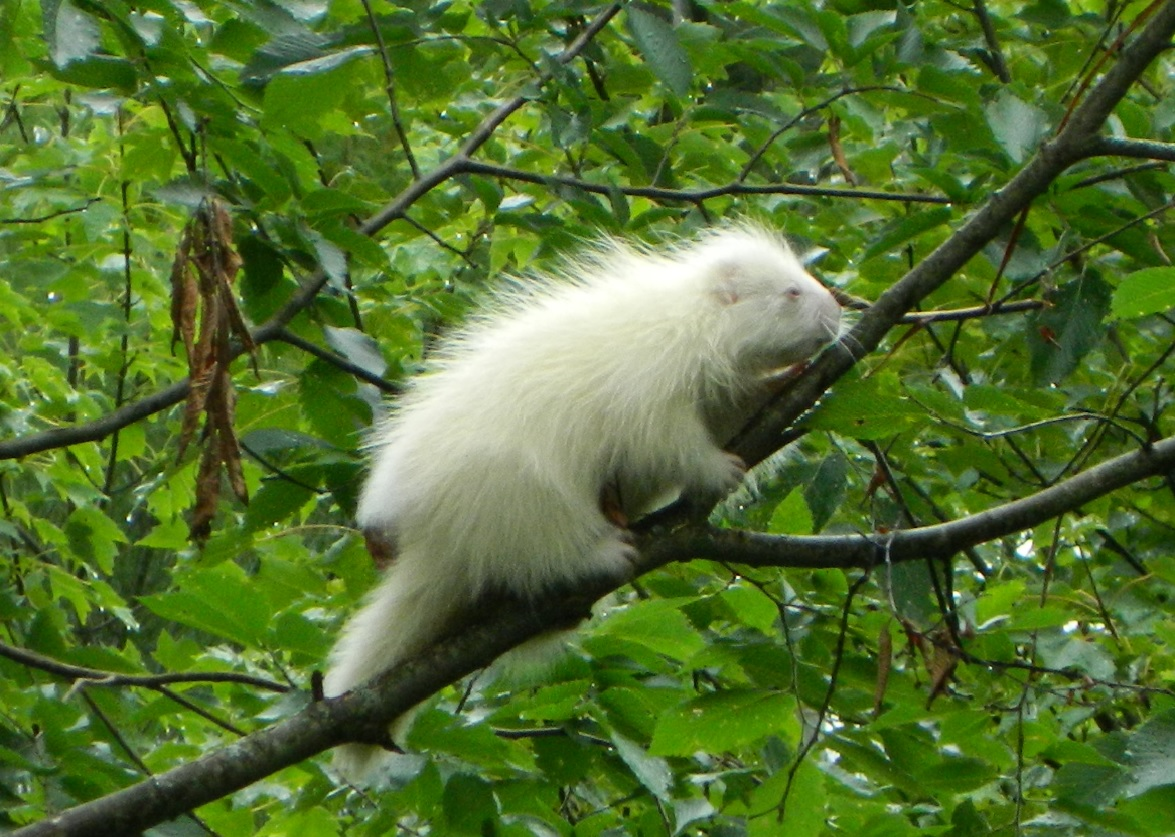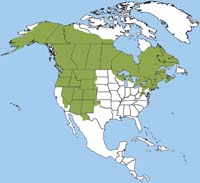|
Porcupine Order: Rodentia Family: Erethizontidae Genus: Erethizon North
American porcupines are large
rodents whose ancestors apparently crossed from Africa to South America
on
floating trees and logs 30 million years ago, and whose most prominent
feature
are the approximately 30,000 quills which grow everywhere individually
out of
the skin musculature, interspersed with bristles, under fur and hair.
The
quills defend the porcupine from attacks by predators, and the only
areas quill
free are the face and underside. This may explain why porcupines are so
often
hit by cars, as their general experience is that larger animals will
avoid
them. The
word porcupine comes from the
old french word porcespin, which roughly translates as thorn
pig. While
there are 58 species of new and old world porcupines, distibuted over
two
different families. our north american version may reach two and a half
feet in
length, with their rotund bodies weighing up to 40 lbs, making them
second to
the beaver as the largest rodent in North America. Porcupines
prefer coniferous and
deciduous forests, with food rich understories, and can live into their
late twenties.
They do not hibernate, but may share wintering quarters with other
porcupines,
in caves, covered depressions, hollowed out logs and trees, etc..
Porcupines
are mostly nocturnal herbivores, eating mainly greens like herbs,
clover and
skunk cabbage during the growing months, while spending much of their
time in
trees in winter, eating tree bark and evergreen needles, while getting
minerals
by chewing on antler sheds. Like
many mammals, they need sodium,
and may be attracted to anything which has been coated with human
sweat, from
wood handled tools and paddles to outhouse toilet seats, or even
anything that
has been peed on, as our urine contains a high sodium content. They’re
also
attracted to the sodium components found in building materials, such as
plywood. Porcupine
mating is generally in
late Summer, and the mating rituals are as strange as the porcupine’s
general
appearance. Females are only sexually receptive from eight to twelve
hours,
once a year, making foreplay and competition among males an urgent
process
indeed! The male does a rather ornate dance, which includes
vocalizations and spraying
urine over the head of the female. Seven
months later, in early Spring,
mom gives birth to a single baby, whose quills are thankfully soft as
they
emerge from the womb, hardening within hours, and within a few days,
the young
one is already foraging, and will stay with Mom for about six months.
Porcupines have a wide vocal range, which includes grunts, shrieks,
wails,
coughs and tooth clicking. Our own
ambassador porcupine,
Shmendrick, seems to whine and moan in pleasure when he eats watermelon
and
butternut squash. Shmendrick was raised at the Refuge after his mom was
killed
by a car, a common fate, as porcupines figure most moving critters will
sensibly avoid them. Shmendrick was released back into the wild several
years
ago, with instructions to go get a job, and then, to our astonishment,
came
back after about two years. We do have many wild porcupines living
within the
Refuge’s 60 acres, but maybe Shmen missed the easy old days of not
having to
provide his own chow. Porcupines
have claws well suited
for climbing, while their hollow quills enable efficient swimming. The
quills themselves
are principally modified hair, coated with keratin, a fibrous
structural
protein which is a main component of hair, fingernails, claws, horns,
etc. The
quills come in a variety of length, thickness and pattern, with the
longest
being on the rump, with the business end of the hollow shaft featuring
a sealed
barbed terminus, making the quills very hard to remove, when the air
tight
quills are warmed by the sun, as well as the skin of the unfortunate
recipient. Porcupines
are attracted to buds on
tree branches and stems which may not handle their weight, so falling
out of
trees is a common porcupine fate. Fortunately, their skin contains
antibiotics,
useful in the event the porcupine quills itself, by falling out of a
tree, or
when males fight during the mating season. Porcupines,
like other predator
targets, would prefer disengagement to fighting, and employ both
audible and
visual cues to warn would be attackers. These include teeth clattering,
turning
its back to display the quilled tail, which may be lashed at the
attacker,
arching the back to make the quills stand up, and shivering to cause
the quills
to rattle and wave menacingly. As with actual contact with the
attacker, the
latter activity may cause some quills to shake loose and fall, which
may be
behind the popular folklore that porcupines can shoot their quills.
They can’t.
Like possums, porcupines can emit a really offensive odor when
frightened or
agitated, in their case, from skin glands called rosette on the lower
back. A
relaxed porcupine can be gently stroked, starting at the head, but
don’t try
this at home. If your
dog gets quilled, and you
can’t pony up the likely expensive vet bill, and you have one seriously
patient
and trusting dog, you can sever the quills midway, to let the air
escape, and
gently twist and pull the embedded remains of the quill. While
porcupines are obviously very
risky targets for predators, they are effectively attacked by cougars,
who may
knock the porcupine out of the tree, somewhat less by great horned owls
and
eagles, and painfully by bears, wolves and coyotes. The porcupine’s
main enemy
is the fisher, whose numbers continue to grow in much of New York
State, as
porcupines increase their numbers and range. Steve Hall |

Adirondack Albino Porcupine by David Plumley

Porcupine, Denali National Park, 2012 by Steve Hall




Wiki - http://www.nhptv.org/natureworks/porcupine.htm#2 - Wiki
Porcupine Quills - Porcupine Range - Porcupine Prints
Come meet our Ambassador Bears & Learn all about Bears
| Home |
Release of
Rehabbed Animals |
Learn
About Adirondack & Ambassador Wildlife |
Critter
Cams & Favorite Videos |
History
of Cree & the Adirondack Wildlife Refuge |






